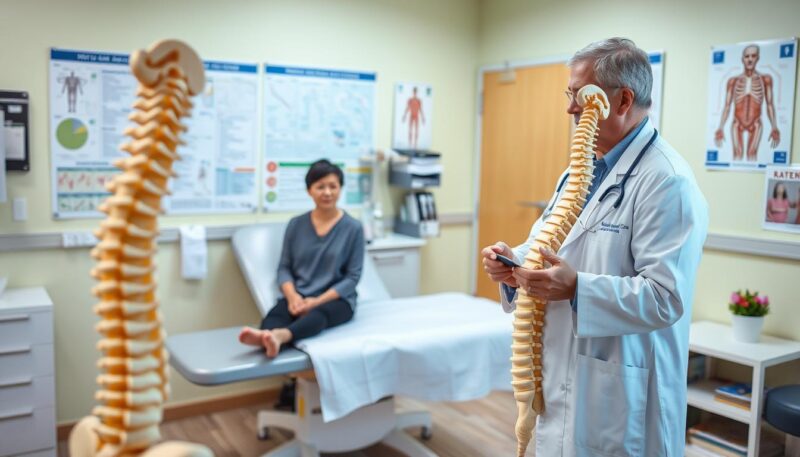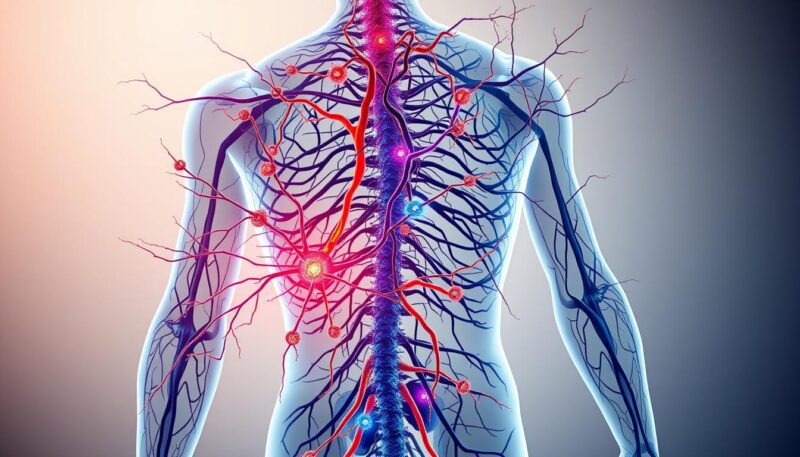
Share Post:
Sciatica can be an incredibly debilitating condition, affecting your lower back, hips, and legs with sharp, sometimes unbearable pain. It’s a condition that impacts nearly 40% of individuals at some point in their lives, particularly starting between the ages of 40 to 50. Knowing which doctor to see for sciatica and understanding the various treatment options available can be crucial in obtaining effective sciatica relief.
This article aims to provide you with expert medical advice, helping you understand who you should consult for your sciatica pain. Multiple practitioners specialize in different aspects of treating sciatica, offering both non-surgical and surgical solutions to alleviate pain and improve quality of life. Reading through, you’ll learn about the roles of primary care physicians, chiropractors, neurologists, orthopedic surgeons, pain management specialists, and physical therapists in treating sciatica.
Table of Contents
ToggleKey Takeaways
- Understanding the role of each type of doctor in treating sciatica is essential for effective pain management.
- Primary care physicians are often the first point of contact for sciatica diagnosis and initial treatment.
- Non-surgical options like chiropractic care and physical therapy can be very effective in many cases.
- Specialists like neurologists and orthopedic surgeons are consulted for more severe or persistent sciatica symptoms.
- Comprehensive treatment plans often involve a multidisciplinary approach, incorporating various medical professionals.
Understanding Sciatica: Causes and Symptoms
Understanding sciatica is essential for identifying and addressing the pain you may be experiencing. Sciatica involves persistent distress caused by irritation or compression of the sciatic nerve, often presenting unique challenges. It’s vital to recognize the causes and symptoms to create an effective treatment plan with the help of back pain specialists.
What is Sciatica?
Sciatica is a condition characterized by pain that extends along the sciatic nerve, which branches from your lower back through your hips and buttocks and down each leg. Sciatica typically affects one leg at a time, although in rare instances, it can impact both legs simultaneously. Sciatic nerve issues arise due to several underlying factors that warrant careful consideration during a sciatica diagnosis.
Common Causes of Sciatica
Several common causes contribute to the development of sciatica. Factors such as herniated disks, spinal stenosis, and bone spurs can lead to lower back nerve compression. Jobs involving prolonged sitting, heavy lifting, or frequent twisting of the back significantly increase the risk of developing sciatic nerve issues. Obesity further contributes to stress on the spine, heightening the likelihood of sciatica. Similarly, diabetes escalates the risk due to potential nerve damage, which underscores the importance of specialized sciatica diagnosis by back pain specialists.
Identifying Symptoms
Identifying sciatica symptoms is crucial for timely and accurate sciatica diagnosis. Common indicators include sharp pain, tingling, numbness, and weakness, predominantly in the lower back, buttocks, and legs. Those suffering from sciatica may also experience sensations that radiate from the back towards the hip or down the leg. Additionally, physical symptoms like leg swelling or inflammation may occur, especially in cases caused by herniated disks, spinal stenosis, bone spurs, or piriformis syndrome.
To ease sciatic pain, different therapeutic approaches are recommended, such as physical therapy, massage, heat application, medications, and maintaining proper posture. While rest is vital, it’s important to balance it with activity to avoid worsening the condition and to support recovery.
Maintaining good posture and engaging in regular exercise can strengthen your core muscles, aiding in the prevention of sciatica. Even so, recurrence is possible, highlighting the need for continual awareness and management of sciatic nerve issues.
| Factor | Impact |
|---|---|
| Herniated Disks | Common in ages 20 to 50, often resolves without treatment |
| Obesity | Increases spinal stress and risk of sciatica |
| Prolonged Sitting | Higher likelihood of developing herniated disks |
| Diabetes | Increases risk of nerve damage, leading to sciatica |
| Improper Lifting Techniques | Contributes to spinal injuries and sciatica |
Role of Primary Care Physicians in Sciatica Diagnosis
The role of primary care physicians is pivotal in the initial stages of sciatica diagnosis. They are often the first point of contact for patients experiencing lower back pain. During the initial consultation, the primary care physicians conduct a comprehensive initial evaluation through a series of steps to determine the underlying causes of sciatica.
Initial Consultation and Evaluation
During the initial evaluation, the physician takes into consideration the patient’s detailed medical history and carries out a thorough physical examination. Recognizing that sciatica affects about 40% of people during their lifetime, these professionals are well-equipped to identify symptoms and assess severity. They may additionally inquire about numbness, weakness in the legs, pain triggers, limitations in activities, and previous treatments.

For patients where symptoms persist or in cases of severe pain, diagnostic imaging such as X-rays, MRI, or CT scans might be recommended. These imaging tests help in accurately identifying any spinal abnormalities that could be causing sciatica.
Referral to Specialists
When the initial evaluation indicates the need for more specialized care, primary care physicians refer patients to appropriate specialists. Common referrals include:
- Chiropractors: For spinal adjustments and non-surgical treatments.
- Physiatrists: Specialize in musculoskeletal treatments, offering a range of non-surgical options.
- Orthopedists/Neurosurgeons: Handle complex cases, particularly when surgery is being considered.
- Pain Management Specialists: Focus on managing persistent pain through various interventions.
- Physical Therapists: Design customized exercise programs to strengthen the core and correct posture, crucial in the non-surgical treatment approach.
This multidisciplinary approach ensures that care for sciatica is comprehensive, targeting both immediate pain relief and long-term recovery.
| Specialist | Primary Role | Common Treatments |
|---|---|---|
| Chiropractor | Spinal Adjustments | Chiropractic adjustments, manual therapies |
| Physiatrist | Musculoskeletal Treatments | Physical therapy, pain management strategies |
| Orthopedist | Spinal Surgery | Spinal surgery, orthopedic interventions |
| Pain Management Specialist | Pain Relief | Medications, injection therapies |
| Physical Therapist | Exercise and Movement Therapy | Customized exercise programs, manual therapies |
Chiropractors: Non-Surgical Relief for Sciatica
If you’re among the 40 percent of people who will experience sciatic nerve pain in their lifetime, finding effective treatment options is crucial. A chiropractor offers non-surgical relief to address the root causes of your pain. Sciatica often stems from compression in the lower back, leading to symptoms like numbness, tingling, muscle weakness, and a burning sensation, predominantly on one side of the body.
Chiropractic treatment begins with a meticulous evaluation that may include a review of your medical history, physical exams, and imaging tests such as x-rays. This comprehensive assessment allows the chiropractor to pinpoint the precise cause of your sciatica, which commonly involves nerve compression due to herniated discs or spinal stenosis.
Once the underlying cause is established, chiropractors employ targeted spinal adjustments to alleviate the pressure on the sciatic nerve. This approach aims to realign the vertebrae, enhancing not only your physical well-being but also potentially improving your metabolism and emotional health. Remember, the sounds heard during these adjustments are not bones cracking, but rather a release of gases from the joints, similar to the sensation of popping a knuckle.
Chiropractic care goes beyond spinal adjustments; it often includes soft tissue techniques such as massage therapy and lifestyle advice to help manage sciatica pain. Given that 80% of individuals will experience back pain at some point, chiropractic adjustments are also a proactive measure to manage spinal health and relieve painful joints from previous injuries.
Delaying chiropractic treatment for sciatic pain can prolong recovery time, making it essential to seek timely care. Your chiropractor will consider various factors, such as your health, dietary habits, fitness level, and existing medical conditions to tailor a treatment plan that offers non-surgical relief and promotes long-term sciatica relief.
Ultimately, individual needs and preferences play a crucial role in deciding whether to see a chiropractor or other specialist for managing sciatica. Chiropractic treatment is a drug-free, non-surgical option that focuses on holistic care, offering a path to pain relief and improved quality of life.
Neurologists: Expertise in Nervous System Disorders
When dealing with sciatica, which influences the lower body, seeking the expertise of a neurologist can prove invaluable. Neurologists specialize in diagnosing and treating nervous system disorders, including sciatica resulting from nerve damage. Understanding when to consult a neurologist and what diagnostic procedures are involved can help you take the right steps toward recovery.
When to See a Neurologist for Sciatica
It’s crucial to see a neurologist if you experience persistent pain, muscle weakness, or neurological symptoms that indicate significant nerve damage. Sciatica often manifests as pain starting in the lower back and radiating through the thigh and leg, typically affecting one side of the body. In rare cases, the pain may impact both sides. If these symptoms interfere with your daily activities, a neurologist equipped to handle nervous system disorders can offer the necessary evaluation and treatment plan to address your condition.

Diagnostic Tests and Procedures
Neurologists employ various advanced diagnostic procedures to assess sciatica and determine the appropriate treatment approach. Common diagnostic tests include:
- MRI Scans: Offer detailed images of the spine and help identify issues such as herniated discs and nerve compression.
- CT Scans: Provide cross-sectional images of the spine to detect structural problems.
- Electromyography (EMG): Measures muscle response and electrical activity in muscles, invaluable for identifying nerve dysfunctions.
- Nerve Conduction Studies: Assess how well and how fast nerves can send electrical signals, helpful in pinpointing nerve damage.
These diagnostic procedures enable neurologists to tailor treatment plans, which may include medication, physical therapy, or in severe cases, surgical intervention. Addressing sciatica promptly with expert care from a neurologist can significantly improve your quality of life and prevent further complications.
Orthopedic Surgeons: Comprehensive Spinal Care
Orthopedic surgeons are instrumental in providing comprehensive care for spinal disorders that cause sciatica. They bring specialized expertise in treating conditions that affect the spine, such as bone or disc issues. Given that approximately 40 percent of Americans will experience sciatica in their lifetime, according to Harvard Health, the role of the orthopedic surgeon is crucial in managing and treating this widespread condition.
When Surgery is Necessary
Surgery is typically reserved for cases where sciatica persists despite other treatments. Up to 90 percent of sciatica cases improve without surgery, underscoring the importance of conservative treatment first. However, when necessary, orthopedic surgeons opt for minimally invasive procedures, which boast a notably high success rate. These procedures are usually considered when patients experience severe pain, significant neurological deficits, or when non-surgical treatments fail to provide relief.
Surgical and Non-Surgical Treatments
Orthopedic surgeons employ a mix of surgical and non-surgical treatments to address sciatica. Non-surgical options often include anti-inflammatory medications, physical therapy, and steroid injections. On the surgical side, techniques such as laminectomy, discectomy, and microdiscectomy are common. These minimally invasive surgeries help alleviate pressure on the sciatic nerve and have a high success rate, making them a preferred choice for many patients.
| Treatment Type | Examples | Success Rate |
|---|---|---|
| Surgical | Laminectomy, Discectomy, Microdiscectomy | High (Notably Effective) |
| Non-Surgical | Anti-Inflammatory Medications, Steroid Injections, Physical Therapy | Up to 90% |
Post-Surgery Rehabilitation
Postoperative care is an essential part of recovery from spinal surgery. Orthopedic surgeons collaborate closely with physical therapists to develop personalized rehabilitation programs. These programs focus on improving strength, flexibility, and posture to ensure a thorough and successful recovery. Consistent postoperative care helps track progress, address any complications, and promote long-term health.
Overall, orthopedic surgeons provide a blend of expertise and compassionate care, tailoring treatment plans to meet the specific needs of sciatica patients and ensuring optimal recovery.
Pain Management Specialists: Focused Pain Relief
Pain management specialists are integral to the comprehensive care needed for sciatica treatment. These medical professionals are skilled in various techniques to alleviate chronic and acute pain, ensuring each patient receives personalized attention. Pain management focuses on addressing pain through a combination of methods, including prescribing pain medication, administering nerve blocks, and performing spinal injections.
One of the primary interventions offered by pain management specialists includes the use of nerve blocks and spinal injections. These procedures are designed to minimize inflammation and pain, providing significant relief for individuals suffering from sciatica. Additionally, pain medication is often utilized to manage symptoms, allowing patients to maintain a better quality of life.
A critical component of pain management is the tailored rehabilitation programs that specialists develop to address each patient’s unique needs. These programs often involve a combination of physical therapy, lifestyle adjustments, and ongoing pain assessments to ensure optimal results. The goal is not only to alleviate immediate pain but also to prevent future episodes, fostering long-term well-being.
“Pain management specialists aim to provide comprehensive care that integrates various therapies, ensuring patients achieve the best possible outcomes for sciatica treatment.”
In delivering effective pain management, specialists frequently collaborate with other healthcare providers such as orthopedic surgeons, neurologists, and physical therapists. This interdisciplinary approach ensures a holistic treatment plan, addressing every aspect of the patient’s condition. By working together, these professionals can offer a synergistic blend of pain medication, rehabilitative exercises, and interventional techniques, promoting overall recovery.
| Intervention | Utilization Rate | Efficacy |
|---|---|---|
| Botox Injection for Pain Relief | 70% | High |
| Trigger Point Injections | 60% | Moderate |
| Nerve Blocks | 80% | Very High |
| Viscosupplementation Procedures | 50% | High |
| Spinal Injections | 75% | Very High |
Physical Therapists: Exercise and Movement Therapy
Enlisting the expertise of a physical therapist is a pivotal step in treating sciatica. Leveraging targeted exercise and movement therapy, these professionals aim to alleviate pain and improve overall function by addressing the root causes of nerve compression. Here, we’ll explore the various facets of physical therapy in managing sciatica.
Customized Exercise Programs
Every sciatica case requires a personalized approach. Physical therapists design customized exercise programs tailored to strengthen the back and core muscles while incorporating stretches for the buttocks, hip, and hamstring muscles. These specific exercises not only help to reduce nerve compression but also enhance cardiac fitness, contributing to an overall healthier lifestyle.
Manual Therapies
Manual therapies are integral to the holistic approach of physical therapists. Techniques such as massage therapy and joint manipulation are utilized to alleviate muscle tension and improve mobility. Passive treatments like hot & cold therapy, transcutaneous electrical nerve stimulation (TENS), ultrasound therapy, and hydrotherapy complement these hands-on methods, providing comprehensive relief from pain symptoms.
Long-Term Management Strategies
A critical aspect of sciatica treatment is long-term management. Physical therapists are committed to helping you maintain improvements and prevent future episodes. They develop long-term management strategies that may include home exercise routines and lifestyle adjustments aimed at sustaining the benefits achieved during therapy. This approach ensures you continue to experience relief and maintain optimal function over time.
| Therapy Type | Key Benefits |
|---|---|
| Exercise Therapy | Strengthens core and back muscles, reduces nerve compression |
| Manual Therapies | Alleviates muscle tension, improves mobility |
| Hot & Cold Therapy | Provides immediate pain relief, reduces inflammation |
| TENS | Stimulates nerves to relieve pain |
| Ultrasound Therapy | Promotes tissue healing and reduces pain |
| Hydrotherapy | Effective for gentle exercise and pain relief in water |
Conclusion
In navigating the path toward sciatica relief, it’s essential to recognize the diverse roles played by various medical professionals. A comprehensive treatment approach often involves consultations with primary care physicians, chiropractors, neurologists, orthopedic surgeons, pain management specialists, and physical therapists. Each specialist brings specialized knowledge tailored to specific aspects of sciatica, which may stem from conditions such as herniated discs, spinal stenosis, or other spinal complications.
From the initial evaluation conducted by a primary care physician to potential surgical interventions performed by an orthopedic surgeon, every step is guided by expert medical care. For many individuals, conservative, non-surgical methods, as emphasized by studies in journals like Spine and Eur Spine J, can be highly effective. The role of exercise, as directed by physical therapists, along with manual therapies and long-term management strategies, cannot be overstated. These methods not only aim to provide immediate pain relief but also help in preventing future occurrences.
For severe cases, where conservative treatment is not effective, surgical options such as microdiscectomy or laminectomy, as referenced in studies published by JAMA, can offer substantial relief. Meanwhile, pain management specialists can administer medications like NSAIDs, muscle relaxants, or corticosteroid injections to manage acute pain episodes. It’s crucial to explore all these sciatica relief strategies under professional guidance to tailor the best course of action suited to your needs.
Ultimately, achieving comprehensive treatment and effective sciatica relief requires a multidisciplinary approach, combining the skills and knowledge of various healthcare providers. By leveraging this integrated care model, you can work towards alleviating pain, improving mobility, and enhancing your overall quality of life.
Source Links
- https://www.frontrangeneurosurgery.com/2018/06/22/who-should-i-go-to-for-my-sciatica/
- https://stanfordhealthcare.org/medical-conditions/back-neck-and-spine/sciatica.html
- https://betterlifephysicaltherapy.com/blog/sciatica-doctor-options/
- https://my.clevelandclinic.org/health/diseases/12792-sciatica
- https://www.mayoclinic.org/diseases-conditions/sciatica/symptoms-causes/syc-20377435
- https://www.ncbi.nlm.nih.gov/pmc/articles/PMC9638590/
- https://www.mayoclinic.org/diseases-conditions/sciatica/diagnosis-treatment/drc-20377441
- https://www.weisshospital.com/news/which-type-of-doctors-treat-sciatica-pain/
- https://www.renospinecare.com/blog/what-to-expect-during-sciatica-pain-treatment-from-a-chiropractor/
- https://www.raintreechiro.com/should-i-go-to-a-doctor-or-chiropractor-for-sciatica/
- https://aica.com/we-treat/conditions/sciatica/
- https://www.procaremedcenter.com/how-do-you-know-if-you-should-see-a-neurologist-or-an-orthopedic-doctor/
- https://www.spinesurgeonla.com/post/top-3-reasons-a-neurosurgeon-for-sciatica-can-help-with-your-pain-relief-treatment-this-october-2022
- https://www.ctortho.com/2024/08/02/best-doctor-to-see-for-sciatica-treatment/
- https://www.eliteorthopaedic.com/blog/sciatica/
- https://www.mayoclinic.org/diseases-conditions/sciatica/doctors-departments/ddc-20377442
- https://www.marietta-chiropractor.com/what-kind-of-doctor-treats-sciatica/
- https://theadvancedspinecenter.com/managing-sciatica-with-physical-therapy/
- https://thedoctorsofpt.com/best-sciatica-doctor/
- https://www.ncbi.nlm.nih.gov/pmc/articles/PMC1895638/
- https://chirosporthealth.com/should-i-go-to-a-doctor-or-chiropractor-for-sciatica-nerve-pain/






